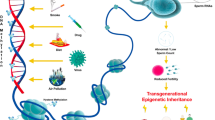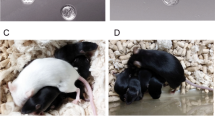Summary
We have improved zygote recovery 11–1,000 fold by optimizing the physiology of gamete release and mating inAcetabularia acetabulum. Gamete release was affected by agar purity, concentration, and volume/gametangial pair. Cold pre-treatment of gametangia (14–30 d at 10°C in the dark) synchronized subsequent gamete release at 21°C in the light. Cold pre-treatment was nearly twice as effective in synchronizing subsequent gamete release when intact, gametangia-bearing caps rather than isolated gametangia were pretreated. Synchronizing gamete release doubled mating efficiency. In a wild-type laboratory strain ofA. acetabulum, there were 1,561±207 gametes/gametangium which had half-lives of 14.5 d in 0.1% seawater-agar. We recovered 48–93% of the expected numbers of zygotes from a mass mating of 8 to 1,226 gametangia and 11–128% of the expected numbers of zygotes from mating single gametangial pairs: the large range in the calculated mating efficiency may be attributable to the variation in the numbers of gametes made per gametangium. Zygote recovery from single gametangial pairs was highly dependent on the volume of mating matrix. In addition, most zygotes recovered were unattached to any other zygotes in the subsequent generation (> 95% single cells from matings of 1–500 gametangial pairs). Our improvements in mating conditions and zygote recovery (1) have facilitated cell manipulation and culture ofA. acetabulum in the laboratory; and (2) have made controlled crosses for selection and genetic analysis of mutants feasible. These advances have removed a major barrier to genetic analysis of development inAcetabularia.
Similar content being viewed by others
Abbreviations
- LB:
-
Luria-Bertani bacteriological broth
- SE:
-
standard error of the mean
- Tg :
-
agar gelling temperatures
- DAPI:
-
4′,6-diamidino-2-phenylindole
References
Abe T, Maeda Y (1986) Induction of macrocyst germination in the cellular slime mouldDictyostelium mucoroides. J Gen Microbiol 132: 2787–2791
Berger S, de Groot EJ, Neuhaus G, Schweiger M (1987)Acetabularia: a giant single cell organism with valuable advantages for cell biology. Eur J Cell Biol 44: 349–370
Bold HC, Wynne MJ (1985) Introduction to the algae. Structure and reproduction. Prentice-Hall, Englewood Cliffs
Cairns E, Gschwender HH, Primke M, Yamakawa M, Traub P, Schweiger H (1978) Translation of animal virus RNA in the cytoplasm of a plant cell. Cell Biol 75: 5557–5559
Coleman AW (1979) Use of the fluorochrome 4′,6-diamidino-2-phenylindole in genetic and developmental studies of chloroplast DNA. J Cell Biol 82: 299–305
Crawley JCW (1966) Some observations on the fine structure of the gametes and zygotes ofAcetabularia. Planta 69: 365–376
Dao S (1962) Recherches biologiques et physiologiques sur quelques Dasycladacées, en particulier, leBataphora oerstedii J. Ag. etl'Acetabularia mediterranea Lam. Rev Gen Bot 69: 409–519
Green BR (1973) Evidence for the occurrence of meiosis before cyst formation inAcetabularia mediterranea (Chlorophyceae, Siphonales). Phycologia 12: 233–235
— (1976) Approaches to the genetics ofAcetabularia. In: Lewin RA (ed) The genetics of algae, vol 12. University of California Press, Berkeley, pp 236–256
—, Burton H, Heilporn V, Limbosch S (1970) The cytoplasmic DNA's ofAcetabularia mediterranea: their structure and biological properties. In: Bonotto S, Kefeli V, Puiseaux-Dao S (eds) Biology ofAcetabularia. Academic Press, New York, pp 35–59
Hämmerling J (1934) Über die Geschlechtsverhältnisse vonAcetabularia mediterranea undAcetabularia wettsteinii. Arch Prostistenk 83: 57–97
— (1963) Nucleo-cytoplasmic interactions inAcetabularia and other cells. Annu Rev Plant Physiol 14: 65–92
Herth W, Heck B, Koop H-U (1981) The flagellar root system in the gamete ofAcetabularia mediterannea. Protoplasma 109: 257–269
Hunt BE, Mandoli DF (1992) Axenic cultures ofAcetabularia (Chlorophyta): a decontamination protocol with potential application to other algae. J Phycol 28: 407–414
Kennedy CK (1971) Induction of colicin production by high temperature or inhibition of protein synthesis. J Bacteriol 108: 10–19
Knoop B (1984) Development in bryophytes. In: Dyer AF, Duckett JG (eds) The experimental biology of bryophytes. Academic Press, New York, pp 143–167
Koop H-U (1975 a) Germination of cysts inAcetabularia mediterranea. Protoplasma 84: 137–146
— (1975 b) Über den Ort der Meiose beiAcetabularia mediterranea. Protoplasma 85: 109–114
— (1975 c) Multinuclear stages of the life cycle ofAcetabularia mediterranea. Protoplasma 86: 351–362
— (1976) Kreuzungsexperimente beiAcetabularia mediterranea. Ber Deutsch Bot Ges 89: 499–505
— (1977 a) Genetic aspects ofAcetabularia mediterranea. In: Wood-cock CLF (eds) Progress inAcetabularia research. Academic Press, London, pp 7–18
— (1977 b) Selection of a morphologically changed strain ofAcetabularia mediterranea. Protoplasma 91: 224–225
— (1979) The life cycle ofAcetabularia (Dasycladales, Chlorophyceae): a complication of evidence for meiosis in the primary nucleus. Protoplasma 100: 353–366
Kuroiwa T, Suzuki T, Ogawa K, Kawano S (1981) The chloroplast nucleus: distribution, number, size and shape, and a model for the multiplication of the chloroplast genome during chloroplast development. Plant Cell Physiol 22: 381–396
Lateur L (1963) Une technique de culture pour l'Acetabularia mediterranea. Rev Algol 1: 26–37
Lewin RA (1956) Control of sexual activity inChlamydomonas by light. J Gen Microbiol 15: 170–185
Lüttke A (1981) Heterogeneity of chloroplasts inAcetabularia mediterranea. Heterogenous distribution and morphology of chloroplast DNA. Exp Cell Res 131: 483–488
— (1988) The lack of chloroplast DNA inAcetabularia mediterranea (acetabulum) (Chlorophyceae): a reinvestigation. J Phycol 24: 173–180
—, Bonotto S (1981) Chloroplast DNA ofAcetabularia mediterranea: cell cycle related changes in distribution. Planta 153: 536–542
Mayer AM, Poljakoff-Mayber A (1982) The germination of seeds. Permagon Press, New York
Menzel D, Elsner-Menzel C (1990) The microtubule cytoskeleton in developing cysts of the green algaAcetabularia: involvement in cell wall differentiation. Protoplasma 157: 52–63
Müller D (1962) Über Jahresund lunarperiodische Erscheinungen bei einigen Braunalgen. Bot Mar 4: 140–155
Neuhaus G, Neuhaus-Url G, de Groot EJ, Schweiger H (1986) High yield and stable transformation of the unicellular green algaAcetabularia by microinjection of SV40 DNA and pSV2neo. EMBO 5: 1437–1444
Neuhaus-Url G, Schweiger H-G (1984) The lid forming apparatus in cysts of the green algaAcetabularia mediterranea. Protoplasma 122: 120–124
Nishimura NJ, Mandoli DF (1992 a) Population analysis of repro-ductive cell structures ofAcetabularia acetabulum. Phycologia 31: 351–358
— — (1992 b) Vegetative growth ofAcetabularia acetabulum (Chlorophyta): structural evidence for juvenile and adult phases in development. J Phycol 28: 669–677
Puiseux-Dao S (1962) Recherches biologiques et physiologiques sur quelques Dasycladacées, en particulier, leBatophora oerstedii J. Ag. et l'Acetabularia mediterranea (Lamouroux). Rev Gén Bot 50: 1–36
Schweiger H-G, Berger S, Kloppstech K, Apel K, Schweiger M (1974) Some fine structural and biochemical features ofAcetabularia major (Chlorophyta, Dasycladaceae) grown in the laboratory. Phycologia 13: 11–20
—, Dehm P, Berger S (1977) Culture conditions forAcetabularia. In: Woodcock CLF (eds) Progress inAcetabularia research. Academic Press. London, pp 319–330
Shephard DC (1970) Axenic culture ofAcetabularia in a synthetic medium. Methods Cell Physiol 4: 49–69
Shihira-Ishikawa I, Kuroiwa T (1984) Morphological transition of the nucleus during the whole life cycle ofAcetabularia calyculus Quoy et Gaimard. Jap J Phycol 32: 147–157
Steinberg PD (1989) Biogeographical variation in brown algal polyphenolics and other secondary metabolites: comparison between temperate Australasia and North America. Oecologia 78: 373–382
Tilney L, Porter KR (1967) Studies on the microtubules in Heliozoa. II. The effect of low temperature on these in the formation and maintenance of the axopodia. J Cell Biol 34: 327–343
Woodcock CLF, Bogorad L (1970) Evidence for variation in the quantity of DNA among plastids ofAcetabularia. J Cell Biol 44: 361–375
—, Miller GJ (1973) Ultrastructural features of the life cycleAcetabularia mediterranea. Protoplasma 77: 313–329
Zeller A, Mandoli DF (1993) Growth ofAcetabularia acetabulum on solid substrata at specific cell densities. Phycologia 32: 136–142
Author information
Authors and Affiliations
Rights and permissions
About this article
Cite this article
Mandoli, D.F., Larsen, T. Improved mating efficiency inAcetabularia acetabulum: recovery of 48–100% of the expected zygotes. Protoplasma 176, 53–63 (1993). https://doi.org/10.1007/BF01378939
Received:
Accepted:
Issue Date:
DOI: https://doi.org/10.1007/BF01378939




